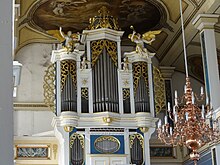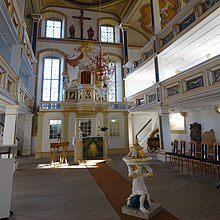Dreifaltigkeitskirche (Graefenhain)

The Dreifaltigkeitskirche is the Protestant church in Graefenhain . The place belongs to the city of Ohrdruf in the district of Gotha in Thuringia .
location
The small village church of the Waldhufendorf is located at the foot of the northeastern roof of the Thuringian Forest at around 450–500 meters above sea level.
history
Duke Friedrich II personally laid the foundation stone for the village church of St. Trinitatis in 1727. Johann Erhard Strasbourg designed erected after one year of construction and consecrated on June 4, 1728 church in the style of Baroque design Thuringian art of the 18th century. In the period that followed, the church was furnished with high quality by the Gotha sculptor Graff, the court painter Georg Conrad Dörffling (pulpit altar and organ prospectus) and the Arnstadt court painter Gottfried Wunderlich , who created the ceiling paintings in 1745. The architect Johann Erhard Straßburger was in charge of construction management for the church . The church was restored from 1993 to 1996. Today it is a protected cultural monument.
Architecture and equipment
Remnants of the previous building on the ground floor have been incorporated into the simple exterior of the hall . Inside the building is decorated with ceiling and gallery paintings from the 19th century, as well as half-length portraits of prophets and evangelists and the resurrection of Jesus Christ . The Gotha historian Johann Heinrich Gelbke (1746–1822) wrote that the church contained two galleries "on both sides for men and below 34 women chairs, each of which can seat 7 to 8 people". Gelbke names the costs for the construction of the church with 4724 Meißner guilders without the costs for the organ and painting.
The ceiling picture is a picture of Martin Luther and the murals of Maria and Johannes above the colored pulpit altar from 1745. A late medieval crucifix from the 16th century comes from the previous building. The west tower is square with a curved slate dome and high lantern .
organ
The Gotha court organ builder Johann Christoph Thielemann supplied the organ in 1731, which today is one of the most important baroque works of the Bach era in Thuringia. It has 22 stops on two manuals and a pedal . The organ was restored in 1996 by the Orgelbau Waltershausen company according to the original plan. The disposition is:
|
|
|
|||||||||||||||||||||||||||||||||||||||||||||||||||||
- Other registers : cymbal star , glockenspiel (treble).
- Coupling : sliding coupler manual-chest, wind coupler pedal-manual.
- Secondary register and playing aids : tremulant , calcant , 3 shut-off valves.
Web links
Individual evidence
- ↑ Lieselotte Swietek: village churches in Thuringia , Thuringia publishing house, 1990, ISBN 3-86087-014-9 , pages 40/41
- ↑ Information about the organ on orgbase.nl. Retrieved January 13, 2020 .
literature
- Ellrich / Heinke / Hoerenz: Between Hörsel and Wilder Gera , ISBN 3-86160-167-2
Coordinates: 50 ° 49 ′ 12 ″ N , 10 ° 42 ′ 11 ″ E



